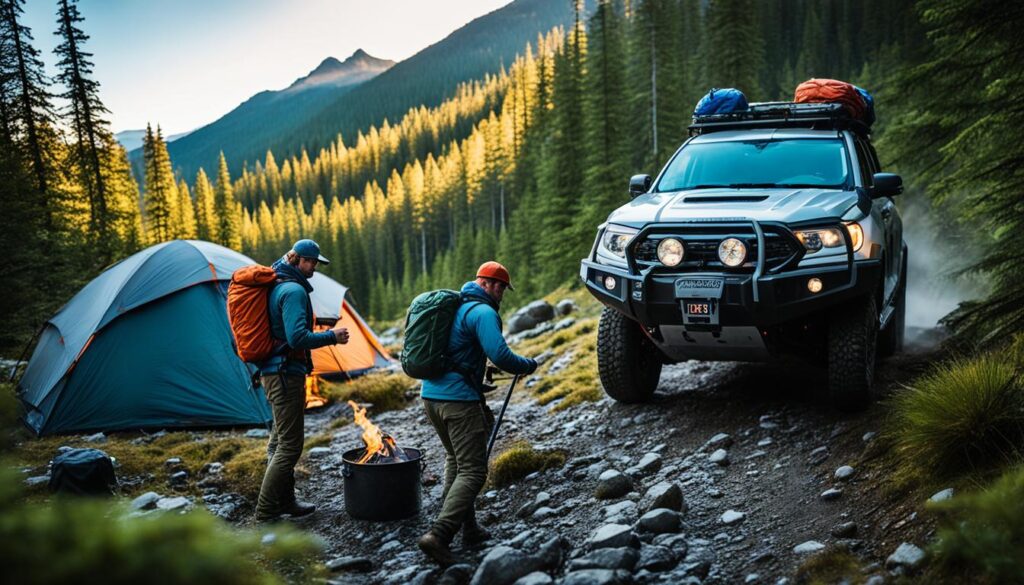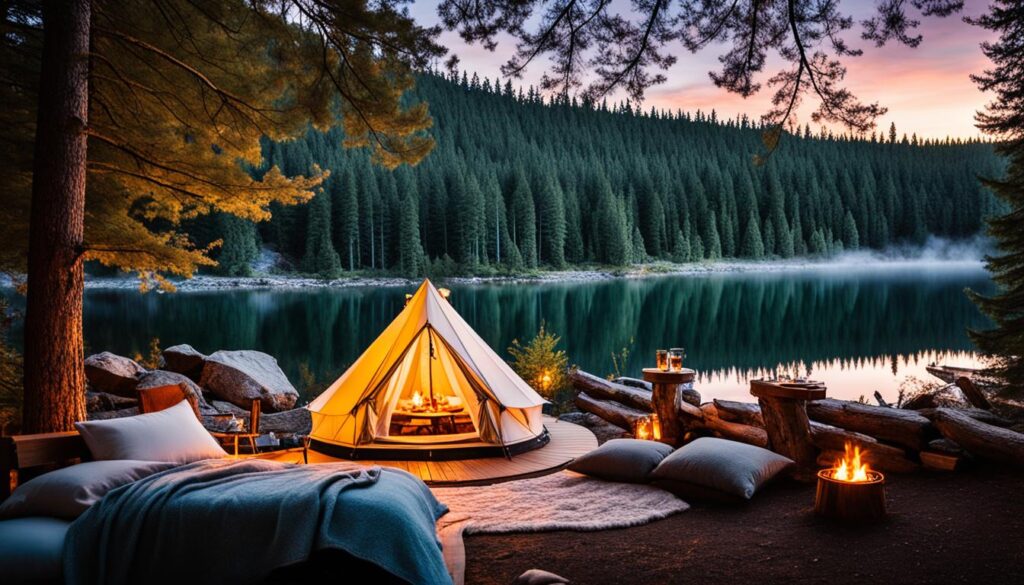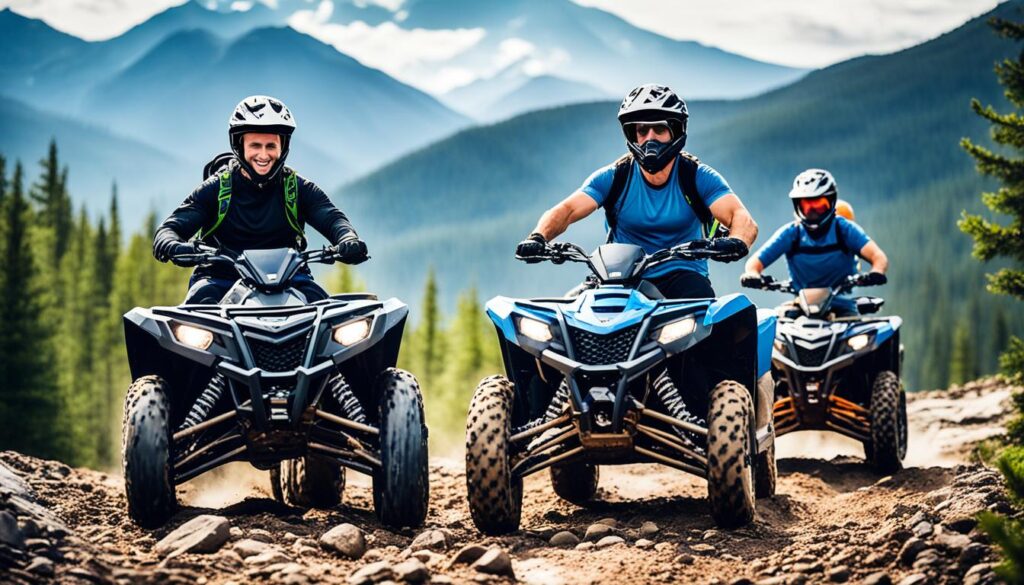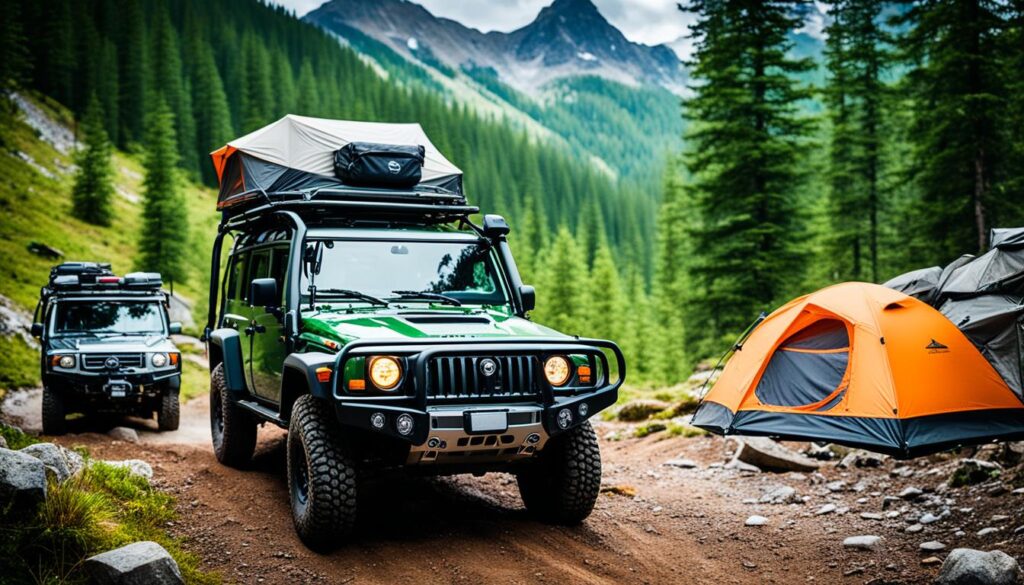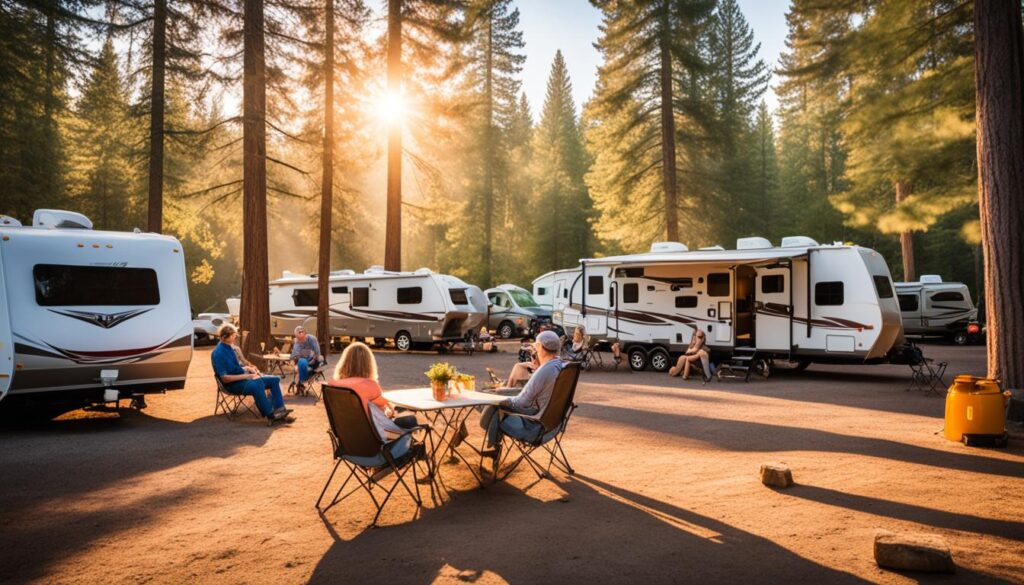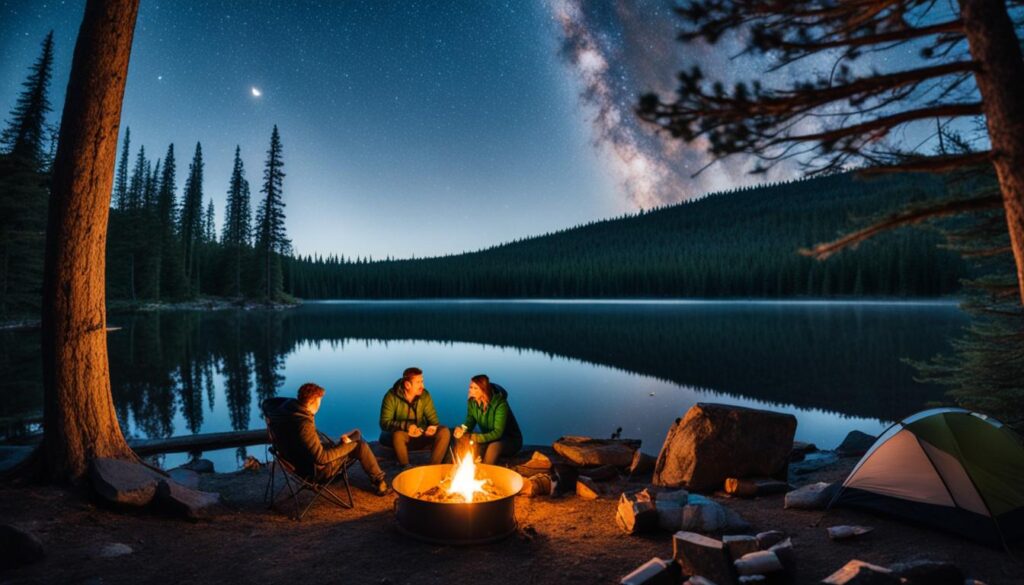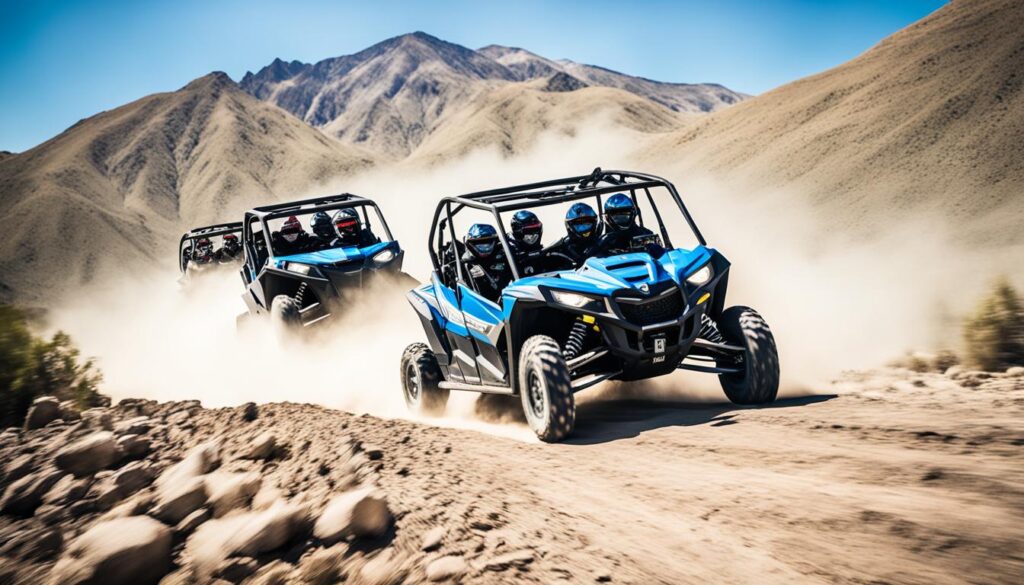Welcome to the beginner’s guide to overlanding! If you’re ready to embark on an adventure that combines off-road exploration, camping in nature, and self-reliant travel, you’re in the right place. Overlanding is a growing trend that allows adventurers to experience the freedom and beauty of the great outdoors while creating unforgettable memories.
As a beginner, it’s important to understand the basics and gather essential tips to ensure a safe and enjoyable overlanding experience. Whether you’re planning to travel solo, with a partner, or in a group, this guide will equip you with the necessary knowledge and resources to get started with confidence.
In this comprehensive guide, I will cover everything from choosing the right vehicle, essential gear, and safety tips to planning your journey and connecting with the overlanding community. By the end of this guide, you’ll have a clear understanding of what overlanding entails and how to make the most of this unique travel experience.
So, get ready to dive into the world of overlanding and discover the beauty of off-road adventures. Let’s begin our journey together!
Key Takeaways:
- Overlanding is a self-sustained travel experience that emphasizes the journey over the destination.
- Choosing the right vehicle is crucial for a successful overlanding adventure.
- Equipping your vehicle with essential gear is necessary for a safe and enjoyable experience.
- Proper planning, route research, and preparation are key to a successful overlanding journey.
- Connecting with the overlanding community can provide valuable support and camaraderie.
Overlanding is a form of self-reliant, vehicle-based travel that emphasizes the journey over the destination. It combines off-road driving, camping, and exploration to provide a unique outdoor experience.
Unlike traditional travel methods, overlanding focuses on the adventure of getting to the destination rather than rushing from point A to point B. It allows travelers to immerse themselves in the natural beauty of the surroundings, discover remote and less traveled areas, and embrace a slower pace of life.
Overlanding is often associated with exploring nature and experiencing off-road adventures. It offers the freedom to travel to remote locations and experience the thrill of venturing off the beaten path. By prioritizing self-reliance, overlanders rely on their own resources and skills to navigate challenging terrains, set up camp, and survive in the great outdoors.
Overlanding vehicles are equipped with everything necessary for off-grid living. They feature sleeping quarters, cooking equipment, and power sources to ensure a comfortable journey. This self-sufficient setup enables overlanders to camp in remote areas without sacrificing basic comforts.
Whether you prefer a rugged 4×4, a camper van, or an adventure-ready SUV, overlanding offers a unique way to connect with nature, challenge yourself, and create lasting memories.
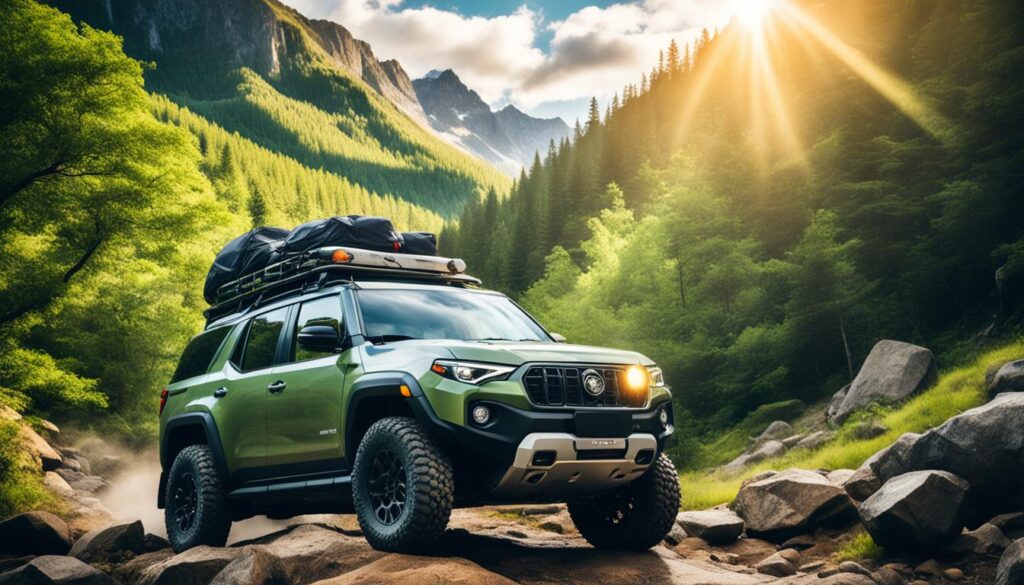
Choosing the Right Vehicle
The choice of vehicle plays a critical role in determining the success of your overlanding experience. It’s essential to select a vehicle that is capable, reliable, and comfortable for long off-road journeys. When choosing the right vehicle for overlanding, consider the following factors:
4x4 Capabilities
An overlanding vehicle needs to have 4×4 capabilities to tackle rugged terrains and challenging off-road conditions. This ensures that you have the necessary traction and control to navigate through various landscapes with ease.
Size and Storage Capacity
Size and storage capacity are crucial considerations when choosing an overlanding vehicle. You need ample space to store essential gear, supplies, and equipment, while still maintaining a comfortable living space. Pick a vehicle that offers adequate interior storage capacity, as well as external roof racks or cargo options.
Fuel Efficiency
Overlanding often involves long journeys and remote destinations, which means fuel efficiency is essential. Choose a vehicle with good fuel economy to maximize your range and minimize the need for frequent refueling.
Availability of Aftermarket Parts
Overlanding vehicles undergo rigorous conditions, so having easy access to aftermarket parts is crucial. Opt for vehicles with a wide range of readily available aftermarket parts and accessories. This ensures that you can find replacements or upgrades quickly, even in remote areas.
Off-Road Performance
An overlanding vehicle should have excellent off-road performance to handle diverse terrains, including mud, sand, and rocky surfaces. Look for features such as high ground clearance, robust suspension systems, and durable tires that can handle challenging off-road conditions.
Popular vehicle choices for overlanding include:
- Pickup trucks
- SUVs
- Adventure vans
These vehicle types offer a balance of versatility, capability, and comfort, making them popular choices among overlanders.
Remember, the right vehicle is the foundation of a successful overlanding adventure. Consider your specific needs, preferences, and budget when making your decision. Once you have chosen the ideal vehicle, you can proceed to equip it with the necessary gear to enhance your overlanding experience.

Choosing the right vehicle is a crucial step in ensuring a successful overlanding experience. Factors such as 4×4 capabilities, size and storage capacity, fuel efficiency, availability of aftermarket parts, and off-road performance should guide your decision. Popular choices include pickup trucks, SUVs, and adventure vans.
Essential Overlanding Products
When it comes to overlanding, having the right gear can make all the difference in ensuring a safe and enjoyable journey. Whether you’re embarking on a weekend adventure or a cross-country expedition, the following essential products are must-haves for any overlander:
Camping Setup
One of the key aspects of overlanding is the ability to set up camp wherever you choose. A roof-top tent or a sturdy ground tent with a comfortable sleeping pad and sleeping bag is essential for a good night’s rest. Don’t forget to pack a durable camping chair and a compact table for dining under the stars.
Portable Power Station and Solar Panels
When venturing off-grid, it’s important to have a reliable power source. A portable power station can keep your devices charged and provide power for essential equipment. Pair it with solar panels for sustainable energy on the go.
Navigation and Communication Tools
Stay on track and connected with reliable navigation and communication tools. A GPS device or smartphone app with offline maps and a two-way radio or satellite communicator can help you navigate unfamiliar terrain and stay in touch with your travel companions or emergency services if needed.
Recovery and Emergency Gear
Prepare for unexpected situations by carrying recovery and emergency gear. A recovery kit with tow straps, shackles, and a winch can help you get out of sticky situations. It’s also important to have a comprehensive first aid kit, a fire extinguisher, and emergency signaling devices such as flares or a signaling mirror.
Cooking and Food Storage Supplies
Overlanding often involves cooking your meals in the great outdoors. Pack a portable stove or grill, cooking utensils, and a mess kit for easy meal preparation. Ensure you have proper food storage containers and a cooler to keep your perishables fresh during your journey.
Water Storage and Purification Systems
Access to clean drinking water is crucial for any overlander. Carry a sturdy water storage container and a water filtration system or purification tablets to ensure a safe and reliable water source in remote areas.
Vehicle Maintenance and Repair Tools
Overlanding can be tough on your vehicle, so it’s important to have the necessary tools for maintenance and repairs. A basic toolkit, tire repair kit, air compressor, and spare parts specific to your vehicle make it easier to handle minor repairs and keep your vehicle in top shape.
By equipping your vehicle with these essential products, you’ll be well-prepared for a self-sustained and adventure-filled overlanding experience.
| Essential Overlanding Products |
|---|
| Roof-top tent or camping setup |
| Portable power station and solar panels |
| Navigation and communication tools |
| Recovery and emergency gear |
| Cooking and food storage supplies |
| Water storage and purification systems |
| Vehicle maintenance and repair tools |
Planning Your Overlanding Journey
Proper planning is essential when it comes to embarking on an overlanding adventure. By taking the time to research your route, set realistic goals, and prepare for the unexpected, you can ensure a safe and enjoyable trip. Here are some key steps to consider when planning your overlanding journey:
1. Research your route
Before hitting the road, it’s important to thoroughly research the route you’ll be taking. Look for scenic trails, off-road tracks, and camping spots along the way. Consider the terrain, weather conditions, and any potential hazards that you may encounter on your journey. Gathering as much information as possible will help you make informed decisions and ensure that your route aligns with your preferences and capabilities.
2. Set realistic goals
It’s important to set realistic goals for your overlanding trip. Determine how many miles you can comfortably cover each day and plan your itinerary accordingly. This will help you avoid rushing through the journey and allow you to fully immerse yourself in the experience. Remember that overlanding is about enjoying the journey rather than reaching a specific destination, so prioritize quality over quantity when planning your daily mileage.
3. Prepare for the unexpected
Overlanding involves venturing into remote areas where unexpected events can occur. Make sure to carry essential supplies such as first aid kits, emergency tools, and extra food and water. It’s also wise to have a backup plan in case of any unforeseen circumstances, such as a change in route or an emergency situation. Being prepared for the unexpected will give you peace of mind and ensure that you can handle any challenges that may arise during your trip.
4. Check your gear
Before setting off on your overlanding journey, thoroughly inspect and test all your gear. Ensure that your camping equipment is in good condition, your vehicle is properly serviced, and your navigation and communication tools are functioning correctly. It’s better to identify any issues or shortcomings before you hit the road, so you can address them and avoid any unnecessary complications during your trip.
5. Practice responsible overlanding
As responsible overlanders, it’s our duty to protect and preserve the natural environment. Minimize your impact by following Leave No Trace principles and respecting local laws and regulations. Be mindful of your campsite selection, dispose of waste properly, and avoid disturbing wildlife and sensitive ecosystems. By practicing responsible overlanding, you can contribute to the sustainability of the areas you visit and ensure that future generations can enjoy them as well.
By following these key steps, you can effectively plan your overlanding journey and set the stage for an unforgettable adventure. Remember to research your route, set realistic goals, prepare for the unexpected, check your gear, and practice responsible overlanding. Happy travels!
Join the Overlanding Community
Connecting with fellow overlanders can be an enriching experience, providing valuable support, knowledge, and camaraderie. There are different ways to connect with the overlanding community and share your love for off-road adventures and exploring the great outdoors.
Here are some ways to connect with overlanders:
- Join online forums: Many online forums cater specifically to the overlanding community, where you can engage in discussions, ask questions, and share experiences with like-minded individuals. Some popular overlanding forums include Overland Bound and Expedition Portal.
- Participate in social media groups: Social media platforms like Facebook and Reddit have active overlanding communities. Joining these groups allows you to connect with overlanders from around the world, ask for recommendations, and share stories and photos of your adventures. Look for groups like “Overlanding Community” or “Off-Road Explorers” on Facebook.
- Attend local meetups and events: Check if there are any local overlanding meetups or events happening in your area. These gatherings provide an opportunity to meet fellow overlanders, exchange tips, and even plan group trips. Websites like Meetup.com might have dedicated overlanding or outdoor adventure groups in your region.
By connecting with the overlanding community, you can gain valuable insights, learn from experienced overlanders, and forge lifelong friendships. Sharing your overlanding experiences and learning from others’ journeys will undoubtedly enhance your own adventures.
Joining the overlanding community has been a game-changer for me. I’ve met incredible people who share my passion for exploration and discovered new destinations and routes that I hadn’t considered before. It’s a supportive community where everyone is eager to help and inspire each other.
-Emma, Overlanding Enthusiast
So, don’t hesitate to join the overlanding community through online forums, social media groups, or by attending local meetups. Connecting with like-minded individuals will help you grow as an overlander and make your journey even more memorable.
| Benefits of Joining the Overlanding Community: |
|---|
| Access to valuable advice and tips from experienced overlanders. |
| Opportunity to share your overlanding experiences and inspire others. |
| Possibility of finding travel companions or joining group trips. |
| Discovering new destinations and off-road routes. |
| Building friendships with like-minded adventurers. |
| Exchanging recommendations for gear, equipment, and vehicle modifications. |
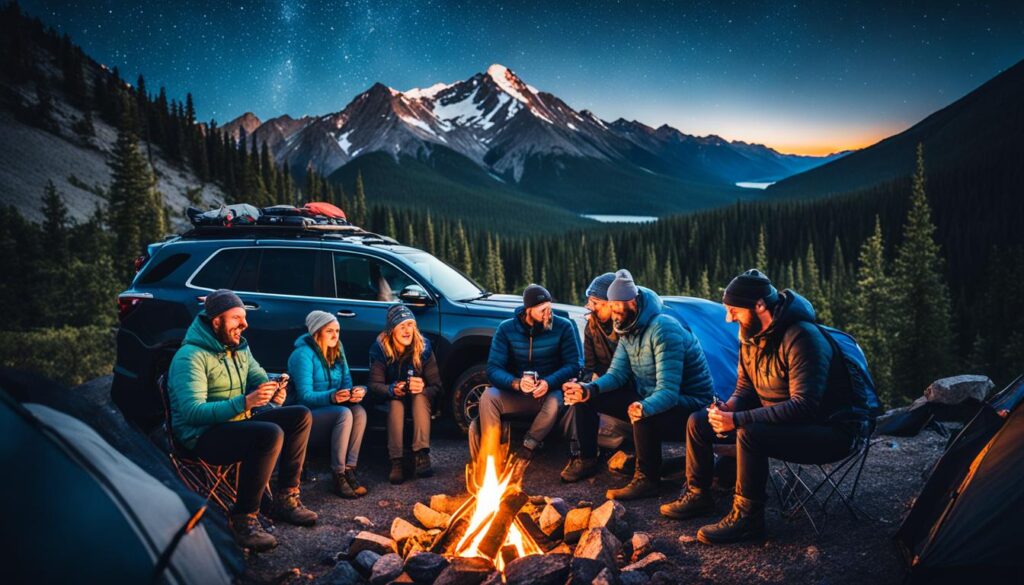
Joining the overlanding community is a fantastic way to enhance your adventures, expand your knowledge, and create lasting connections with fellow overlanders. Embrace the spirit of exploration and start connecting with others who share your passion for overlanding!
How to Get Started Overlanding
Getting started with overlanding is an exciting adventure that requires a proper setup and preparation. In this section, I will guide you through the essential steps for beginning your overlanding journey. From choosing the right gear to vehicle maintenance, we’ll cover everything you need to know to get started.
1. Equip Your Vehicle with the Right Tires
Selecting the appropriate tires for your overlanding vehicle is crucial. Look for all-terrain or mud-terrain tires that offer good traction on different terrains. Make sure they are durable and resistant to punctures. These tires will provide the necessary grip and handling capabilities for off-road driving. Consider popular brands such as BFGoodrich, Goodyear, or Falken for reliable tire options.
2. Ensure Four-Wheel Drive Capability
Four-wheel drive (4WD) is essential for overlanding as it improves traction and allows your vehicle to navigate challenging off-road conditions. Vehicles with 4WD distribute power to all four wheels, providing better control and stability. Ensure that your vehicle has a functional 4WD system and familiarize yourself with its operation before your trip.
3. Gather Essential Camping and Survival Supplies
When embarking on an overlanding adventure, it’s important to have the right camping and survival supplies. Consider items such as:
- Tents or rooftop camping setups for comfortable sleeping arrangements.
- Cooking supplies and food storage solutions for preparing meals on the go.
- Water storage and purification systems to ensure a reliable supply of clean water.
- Essential survival gear, including a first aid kit, emergency communication devices, and tools for self-recovery.
Brands like Yeti, Coleman, and Black Diamond offer durable and reliable camping and survival gear suitable for overlanding.
4. Prioritize Vehicle Maintenance
Before setting off on your overlanding adventure, conduct a comprehensive vehicle inspection and perform necessary maintenance tasks. This includes:
- Checking the engine oil, coolant levels, and brake fluids.
- Inspecting the tires for proper inflation, tread wear, and any signs of damage.
- Testing the vehicle’s electrical system, including the battery and wiring.
- Ensuring all lights, indicators, and wipers are functioning correctly.
If you’re not comfortable with vehicle maintenance, consider taking your vehicle to a trusted mechanic specializing in off-road vehicles for a thorough inspection.
By following these steps and ensuring your vehicle is properly equipped and maintained, you’ll be well-prepared to begin your overlanding adventure. Embrace the spirit of self-reliance and exploration as you embark on this exciting journey.
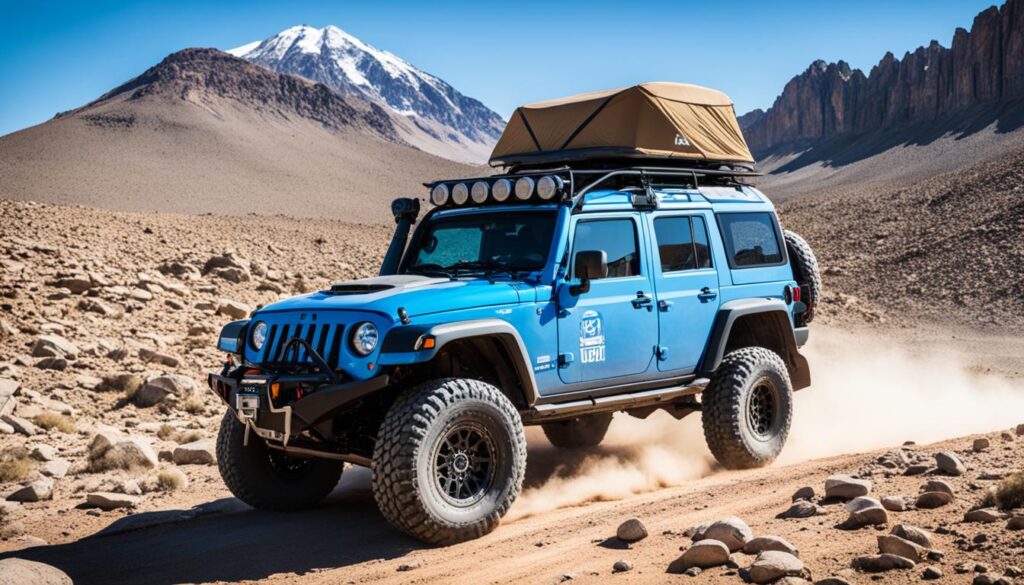
How to Prep Your Vehicle for Overlanding
Preparing your vehicle for overlanding is essential to ensure a safe and successful adventure. Here are some key steps to follow:
Choosing the Right Tires for Overlanding
One of the most important aspects of prepping your vehicle for overlanding is selecting the right tires. Off-road tires with a durable tread pattern and good traction are crucial for navigating various terrains. Consider the type of off-roading you’ll be doing, such as mud, rock, or sand, and choose tires accordingly. Invest in high-quality all-terrain or mud-terrain tires that can withstand the demands of overlanding.
Ensuring Four-Wheel Drive Capabilities
Four-wheel drive (4WD) is essential for tackling challenging off-road conditions during your overlanding journey. Make sure your vehicle is equipped with 4WD capabilities and ensure it’s functioning properly. Check the transfer case, differential locks, and drivetrain components to ensure everything is in good working order. If necessary, consult with a professional mechanic to ensure your 4WD system is in optimal condition.
Equipping Your Vehicle with Camping and Survival Supplies
Being self-sufficient is a crucial aspect of overlanding. Equip your vehicle with essential camping gear such as a tent, sleeping bags, cooking equipment, and food storage containers. Additionally, include survival supplies like a first aid kit, navigation tools, emergency communication devices, and extra fuel and water. Having the necessary supplies will ensure you’re prepared for any situation that may arise during your overlanding journey.
Scheduling a Vehicle Inspection and Performing Maintenance Tasks
Prior to embarking on your overlanding adventure, schedule a comprehensive vehicle inspection. This will help identify and address any potential issues that could arise during your journey. Inspect the vehicle’s engine, brakes, suspension, and other critical components to ensure they are in optimal condition. Additionally, perform routine maintenance tasks such as changing fluids, replacing filters, and inspecting belts and hoses. Regular maintenance will help prevent breakdowns and keep your vehicle running smoothly throughout your overlanding trip.
By following these steps and prepping your vehicle accordingly, you’ll be ready to embark on an incredible overlanding adventure. Ensure your tires are suitable for off-road conditions, have reliable four-wheel drive capabilities, equip your vehicle with essential camping and survival supplies, and perform a thorough vehicle inspection. Preparing your vehicle will give you peace of mind and allow you to fully enjoy the excitement and freedom that overlanding offers.
| Choosing the Right Tires | Ensuring Four-Wheel Drive | Equipping with Camping and Survival Supplies | Scheduling a Vehicle Inspection and Maintenance |
|---|---|---|---|
| Consider type of off-roading | Ensure 4WD system is functioning properly | Include tents, cooking equipment, first aid kit | Schedule comprehensive vehicle inspection |
| Invest in high-quality off-road tires | Check transfer case, differential locks | Navigation tools, emergency communication devices | Inspect engine, brakes, suspension |
| Choose all-terrain or mud-terrain tires | Consult with a professional mechanic if needed | Extra fuel and water | Perform routine maintenance tasks |
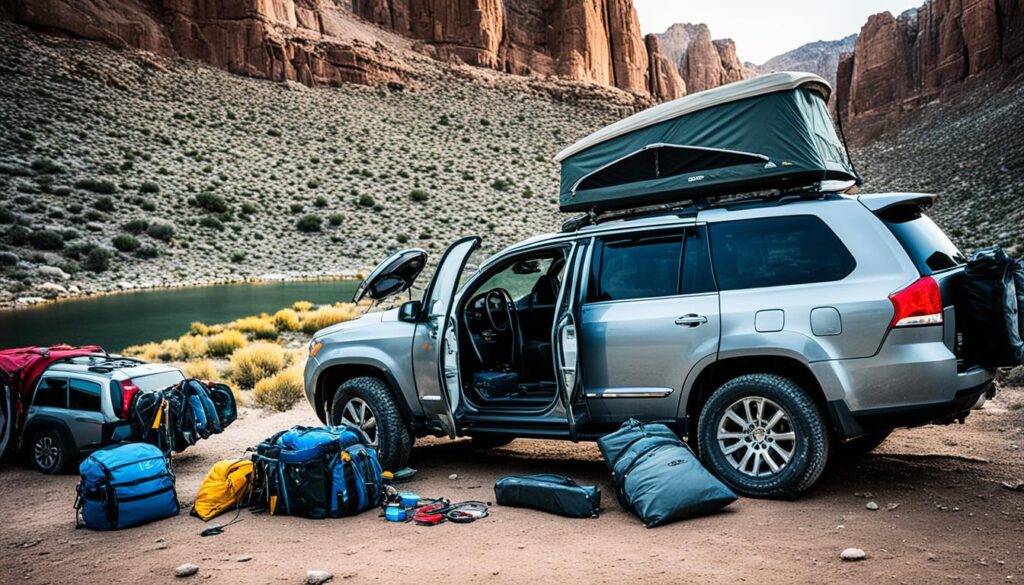
Conclusion
Wrapping up our guide to overlanding for beginners, I hope you now feel equipped and inspired to embark on your own off-road adventure. Overlanding can be an exhilarating and fulfilling experience, allowing you to explore the beauty of nature while challenging yourself in new ways.
As you start your overlanding journey, remember to prioritize safety, preparedness, and conservation. Follow the essential tips and guidelines we’ve discussed, such as choosing the right vehicle, equipping yourself with essential gear, and proper trip planning. By doing so, you’ll ensure a smoother and more enjoyable experience.
Finally, take a moment to appreciate the freedom and uniqueness that overlanding offers. Disconnect from the hustle and bustle of everyday life, and immerse yourself in the stunning landscapes and adventures that await you. Whether you’re traveling solo, with friends, or joining the overlanding community, cherish every moment and create memories that will last a lifetime.
In conclusion, I wish you safe travels and incredible discoveries on your overlanding journey. May your experiences be filled with joy, self-discovery, and a deep appreciation for the wonders of the great outdoors. Happy overlanding!
FAQ
What is overlanding?
Overlanding is a form of self-reliant, vehicle-based travel that emphasizes the journey over the destination. It combines off-road driving, camping, and exploration to provide a unique outdoor experience.
How do I choose the right vehicle for overlanding?
Consider factors such as 4×4 capabilities, size and storage capacity, fuel efficiency, availability of aftermarket parts, and off-road performance when choosing a vehicle for overlanding.
What are the essential products for overlanding?
Essential overlanding products include items such as a roof-top tent or camping setup, portable power station and solar panels, navigation and communication tools, recovery and emergency gear, cooking and food storage supplies, water storage and purification systems, and vehicle maintenance and repair tools.
How do I plan my overlanding journey?
Plan your overlanding journey by researching your route, setting realistic goals, preparing for the unexpected, checking your gear, and practicing responsible overlanding by minimizing your impact on the environment.
How can I join the overlanding community?
Connect with fellow overlanders by joining online forums, social media groups, or attending local meetups and events to share experiences, tips, and advice with like-minded adventurers.
How do I get started with overlanding?
To get started with overlanding, equip your vehicle with the right tires, ensure you have four-wheel drive, and have essential camping and survival supplies. Additionally, maintain your vehicle and get a comprehensive vehicle inspection before embarking on your overlanding adventure.
How do I properly prep my vehicle for overlanding?
Prep your vehicle for overlanding by choosing the right tires, ensuring four-wheel drive capabilities, having necessary camping and survival supplies, scheduling a vehicle inspection, and performing maintenance tasks to ensure the vehicle is in optimal condition for the journey.
Any final thoughts on overlanding for beginners?
Overlanding for beginners can be an exciting and rewarding adventure. By following the essential tips and guidelines mentioned in this guide, beginners can confidently embark on their overlanding journey while prioritizing safety, preparedness, and conservation. Safe travels!
